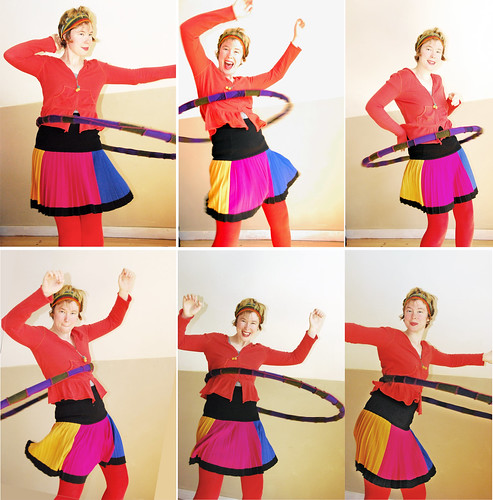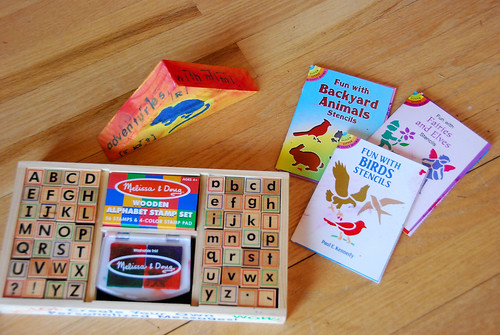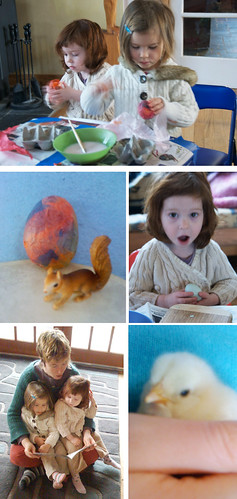 I found some great books at the library this week while browsing through the stacks. I plan to review some of them and I'll let you know how the kids respond to them. Today I enjoyed reading a very special book to kids in my Parent and Me Nature Explorers class at Pen Park.
I found some great books at the library this week while browsing through the stacks. I plan to review some of them and I'll let you know how the kids respond to them. Today I enjoyed reading a very special book to kids in my Parent and Me Nature Explorers class at Pen Park.Tuesday, March 24, 2009
A Library Gem- 'In A Nutshell'
 I found some great books at the library this week while browsing through the stacks. I plan to review some of them and I'll let you know how the kids respond to them. Today I enjoyed reading a very special book to kids in my Parent and Me Nature Explorers class at Pen Park.
I found some great books at the library this week while browsing through the stacks. I plan to review some of them and I'll let you know how the kids respond to them. Today I enjoyed reading a very special book to kids in my Parent and Me Nature Explorers class at Pen Park.Friday, March 20, 2009
Hula Hooping: Fun for Kids and Adults Alike

I have made many large adult size hula hoops, which make great exercise devices. I often use them in my kids classes as well. Although they are too large for young children to actually hoop with they are great for many other activities both physical and mental.
- Defining a Space: Put the large hoop in the grass and observe the natural world within it. when you look carefully or with a magnifying glass you see so many types of plants, minerals, and insects all within such a small space.
- Burn off Some Extra Energy: Have the children roll the hoop down a hill. They make the hoops race or try to aim them at a target. They are big round objects, but not terribly heavy, so young kids can get a great workout and have a blast dragging the hoops back up the hill all by themselves. I often play this game if the kids seem really hyper and I need them to be calm and focused for a craft project.
- Make an Obstacle Course: Jump from hoop to hoop, jump through the hoops, toss objects into the hoops, etc...
- Round and Round: Toddlers like to try to hula hoop, so hold the large hoop for them let them spin around while you spin the hoop around them.
- Hoop for Entertainment: With some practice, you can get quite proficient at Hula Hooping and learn some impressive tricks, such as 'the lift' or hoop several hoops at once. The large adult size hoops are much easier to do that the small light ones found at toy stores. Don't be shy, give it a try! And put on an entertaining show for the kiddies!
How to Build Your Own Hula Hoop:
All the materials you need can be found at a hardware store and will cost you about $35 and provide enough material to make 9 adult size hoops.
You Need:
- a PVC pipe cutting tool
- 1 roll of 1/2" or 3/4" black irrigation tubing
- 9 matching couplings
- Colored electrical tape to decorate your hoop
- Shape a length of tubing into a circle of your desired size. Waist high is a good custom size, but you can go larger or smaller. Smaller sizes require you to hoop faster giving a more rigorous workout, while larger sizes let you hoop at a slower speed.
- Cut the tube with PVC cutter. You can add some beans or sand at this point, if you want the hoop to be waited or make a sound.
- Dip ends into boiling water or heat with a hair dryer to soften and make inserting the coupling easier. Inserting the coupling is the hardest part; you want to get the ends of the tubing as close together as possible. Keep heating and easing the ends together little by little.*
- Wrap the hoop all up with tape, try to make the color combo appealing and make it as pretty and smooth as possible.
- Hoop Away!!!!
*The hoop pictured above is one that I made and it is covered with serged together felted wool sweaters. I made the cloth tube and then pulled it over the irrigation tubing BEFORE inserting the coupling. The ends were stitched together by hand. I'm quite proud of my nifty invention. If you end up using this idea, please leave a comment and send me a picture!
If you are one of those people who have never been able to hula hoop before, fear not, I used to be one of those people before I discovered BIG HOOPS. I didn't get the hang of it right away, but with some practice and proper instruction, I was soon on my way to hooping paradise.
How to Hula Hoop:
Lets see if I can explain this without an actual demonstration. A key thing to know is it is not a round and round movements with the hips. It is more a back and forth shifting of weight to a perfectly even rhythm. Listening to music while hooping, often helps. With big hoops you don't have to start gyrating right away. Hold the hoop with two hands and give it a strong spin around your waist. Stand still and let the hoop fall to the ground. Did you notice how it went around you several times without you even moving? Now repeat that action, but with one foot slightly in front of the other start shifting your weight back in forth to the same rhythm that the hoop is spinning around your torso. Catch it on the second rotation, when the hoop is slightly behind you, then you move forward to catch it, forward and back, forward and back. Good luck and have fun!
Wednesday, March 18, 2009
Class #5: Stamping and Stenciling on Scrap Wood

My husband, Jason Roberson, supplied us with a box full of wooden triangles, which were cast-offs from a recent carpentry project. The kids painted the triangular "mountains" with tempera paints and then stenciled them with various Birds, Backyard Animals, and Fairies and Elves stencils from Dover. They also stamped onto the "mountains" with a Melissa and Doug stamp kit. We lined up all the creations to make a mini mountain range.
The wooden pieces do not need to be primed for this project. The wood takes the tempera paint and stamping very well. If you want to paint wood pieces to use as a toy, I recommend sealing the wood with melted beeswax after painting and stamping.
CousCous and Quimble: the joys of backyard chicken keeping
Here are Cous Cous (the little one) and Quimble (the big one). They are meeting for the first time and to my pleasant surprise they get along great! The full grown chickens are a little less welcoming, but I will be easing these two into the flock little by little. Every day is an adventure with chickens. Becoming a chicken keeper is one of the best decisions that I have ever made. If anyone reading this blog is interested in getting a backyard flock of their own, I say "do it!". They are fun, useful, and low maintenance pets, not to mention the eggs are phenomenal. I just joined a local Charlottesville organization called C.L.U.C.K (Charlottesville League of Urban Chicken Keepers). Isn't that just the best acronym ever? They have a blog and a facebook page so you can join this lively group of poultry enthusiasts.
Tuesday, March 10, 2009
Snacking and Crafting: How to Make a Birdfeeder- Class #4
We enjoyed deliciously ambient weather last Thursday and I couldn't be more pleased with how the class went. We began outside doing a little "yard work": planting bulbs and digging and raking with child sized tools. After that we enjoyed some hoola-hoop games on the front lawn. Rolling large hoola-hoops down the hill and then dragging them back up was a good way to expend some energy before sitting down and making a craft project.
Bird Buffet: a Bird Feeder Tutorial
What you need:
- pipe cleaners
- Cheerios breakfast cereal
- Birdseed
- popcorn
- Tahini thickened with flour
- pinecones
- blunt needles
- string
- cardboard or thick paper
1) Begin by having the children thread the cheerios through the pipe-cleaners.
2) Twist ends of pipe cleaners together to make a ring. You can link together several rings if you'd like.
3) Use blunt needle and thread and carefully thread through some pinecones (ages 5+). Attach pinecone decoration to cheerio ring.
4) Paint on tahini mixture all over the entire piece. It make a glue for the birdseed and the popcorn. Peanutbutter can be used here, but tahini (sesame paste) makes a good peanut substitute.
5) Allow to dry on the cardboard for 2 hours and then hang the feeder from a nearby tree. Watch the birds enjoy the buffet!
Seed Starting and Swapping
Two weeks ago my friends Alp and Ingrid hosted a Seed Swap Party. It was so cleverly organized. Everyone brought their seeds and there were little baggies to put them into for trading. I now have the most eclectic mix of seeds and a compendium of knowledge about gardening from my green-thumbed friends. A seed swap is a great way to get heirloom varieties and learn what does well in your area.
Now my little seedling are starting to sprout; it is a very exciting time. I made all their little starter pots out of recycled newspaper using this nifty little wooden gadget called a Pot Maker. I used Fox Farm brand potting soil which contains earthworm castings and bat guano.
Wednesday, March 4, 2009
Class #3- Fun with Eggs!
 Last Thursday we had our third Adventures with Mimi class at my home. Everyone gathered outside the chicken coop where there were hard-boiled eggs from my chickens to snack on. The children enjoyed peeling the eggs themselves. Next they got to gather eggs from the coop and feed the chickens some cracked corn and yogurt, yum!
Last Thursday we had our third Adventures with Mimi class at my home. Everyone gathered outside the chicken coop where there were hard-boiled eggs from my chickens to snack on. The children enjoyed peeling the eggs themselves. Next they got to gather eggs from the coop and feed the chickens some cracked corn and yogurt, yum!Inside I demonstrated the strength of an egg-shell. What you do is hollow out four eggs and put the halves on a flat surface, you can then put several very heavy books on top of the four shells without them breaking. Even though the shell are thin the shape of the dome of the egg is structurally sound. This allows the mother hen to sit right on her eggs for 22 days straight.
At the end of the class the children had two books to choose from: an Egg is Quiet by Aston and Long or So Happy by Henkes and Lobel. They chose So Happy because of its breathtaking Van Gogh-like illustrations.
Tutorial: How to Make Egg Shakers
We made egg shakers for our craft project. Here's what you need: eggs, strong tape, colored tissue paper, lentils, spoons, brushes, and white glue diluted with water.
1) Have an adult put a small hole with a sterilized nail into the egg and open the hole until you are able to shake out the insides. Save the insides for later to make an omlett. Rinse out emptied shell and pat dry.
2) Use a teaspoon to half fill the egg shell with dried lentils.
3) Cover hole up with masking tape.
4) Cover egg completely with white glue and water mixture. You can brush it on or dip the egg into the mixture.
5) Rip pieces of colored tissue paper and smooth them onto the egg. You can keep adding glue and paper, layering and smoothing carefully as not to crush the egg.
6) Leave the now colorful egg overnight to dry. In the morning it will be hardened like paper-maché and you'll have a new musical instrument!




